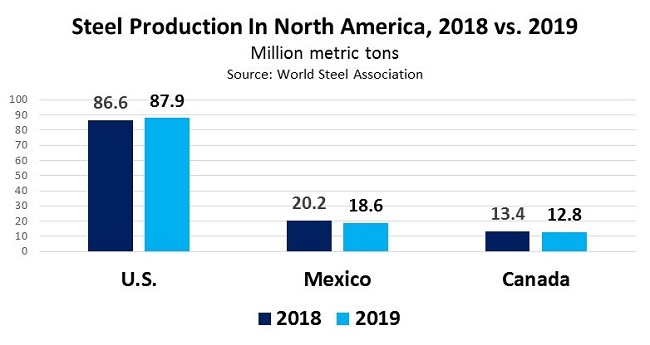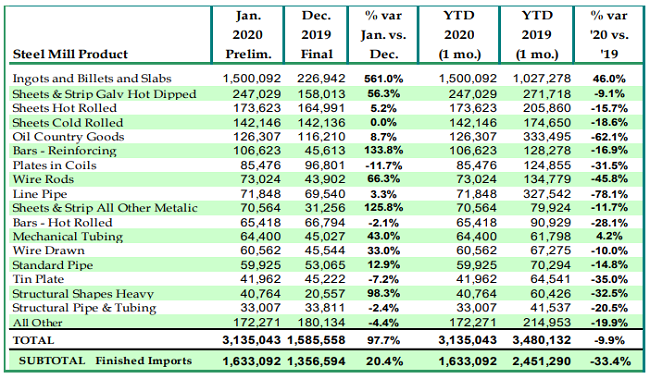Heading into 2020, ferrous scrap recyclers in North America had ample reason to be optimistic. Following a very difficult 2019 that saw benchmark prices for No. 1 Heavy Melt fall from more than US$300 per gross ton in January 2019 to nearly $180 per ton at the start of the 4th quarter, market sentiment improved significantly in the first quarter of 2020.
The trade outlook improved considerably with the coming passage of the United States-Mexico-Canada Agreement (USMCA) and phase one of the U.S.-China trade deal early in the year, along with China’s expected reclassification of certain scrap metal grades from waste to raw materials. U.S. monetary policy was more accommodative late in 2019 and became even more so in early 2020 with the half point rate cut announced in mid-February 2020 (followed by a commensurate Canadian rate cut), which could help revive North American business investment levels.
Additionally, the economic fundamentals in North America remain mostly solid with continued healthy U.S. nonfarm job gains in February (+273,000), low unemployment rates, and signs of improved factory orders and construction spending. The World Steel Association reports crude steel production the United States increased 2.5 percent year-on-year in January 2020 to more than 7.7 million metric tons, helping to offset the struggling steel production trends in Canada and Mexico.

Trade Flows in Focus
U.S. ferrous scrap exports, excluding stainless steel and alloy steel, grew by a modest 1.2% in 2019 to nearly 15.9 million metric tons as improved shipments to Turkey, Malaysia, Saudi Arabia, Vietnam, Bangladesh, and others more than offset weaker business with Egypt, China, and Mexico. Turkey not only retained its place as the largest export destination for U.S. ferrous scrap, but also posted the largest net volume gain (+524,000 mt to more than 3.9 million tons) last year. Improved Turkish buys early in 2020 helped to underpin domestic ferrous scrap prices, although obsolete scrap tags were only seen as holding steady late in the first quarter.
On the import side of the equation, the American Iron and Steel Institute reports the “U.S. imported a total of 3,135,000 net tons of steel in January 2020, including 1,633,000 net tons of finished steel (down 9.9% and 33.4%, respectively, vs. January 2019).” According to AISI, the largest volume of U.S. finished steel imports came from South Korea, Brazil, Japan, and Turkey. Meanwhile, Argus Media reports that “The US International Trade Commission decided against placing dumping duties on fabricated steel imports from Canada, China and Mexico in a rare trade case win for importers.”

Coronavirus and Other Concerns Cloud the Outlook
Heading into 2020, a number of North American steel manufacturers had announced major capacity expansion plans, with accompanying gains expected in ferrous scrap consumption. But concerns about end-market demand and recent coronavirus worries may be having a dampening effect on investment plans, despite the recent Fed rate cuts. For example, Fastmarkets AMM reports “Executives at BlueScope warned that the escalating spread of the novel coronavirus (2019-nCoV) could delay the $700-million expansion of its electric-arc furnace (EAF) operations in Ohio, due to supply chain disruptions. The potential interruption would not be ‘significant,’ Mark Vassella, chief executive officer of the Australian steel producer, said during the company’s half-year earnings call on Monday February 24.” In addition, Argus reports “Liberty Steel confirmed it has put its new EAF install on hold at its Georgetown, South Carolina, wire rod mill while it revaluates. The existing melt shop was idled in September 2019. Liberty has been supplying the mill with billet from its Illinois mill (ex-Keystone). Also for the record, it closed on its acquisition of bankrupt bar mill Bayou Steel on January 31.”
Ferrous Market Forecasts
Looking forward, the World Steel Association projects Chinese steel demand will only grow 1.0 percent in 2020 while steel demand in the rest of the world will increase 2.5 percent, driven by 4.1 percent growth in emerging and developing economies excluding China. As a result, global steel demand is forecast to grow 1.7 percent to 1,805.7 million metric tons in 2020, down from the 3.9 percent growth rate in 2019. But as with other commodities, any improvement in global trade relations could have outsized implications for the global steel and ferrous scrap markets. According to the U.S. Trade Representative’s press release earlier this year, China has agreed to import at least $120 billion of U.S. manufactured goods in 2020, including iron and steel products. Improved trade deals with major trading partners including the U.S., China, Canada, and Mexico will play an important role for the North American iron and steel industries, along with ferrous scrap availability, pricing, and steel capacity expansion plans.